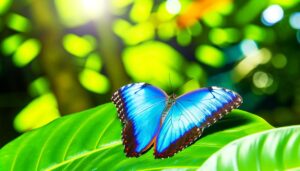How Do Blue Morpho Butterflies Adapt in the Rainforest?
Blue Morpho butterflies exhibit intricate adaptations enabling their survival in the rainforest. Their vivid blue wings use structural coloration to create iridescence, confounding predators, while the ventral side's cryptic coloration aids in camouflage.
This dual coloration also plays a role in intraspecific communication, essential for mating success. They primarily feed on fermenting fruits and tree sap, contributing to nutrient cycling within the ecosystem.
Their erratic flight patterns and territorial behaviors further aid in predator evasion and mating. The butterflies undergo a complex life cycle with stages that guarantee successful development and minimal predation, showcasing evolutionary sophistication.
Discover their multifaceted adaptations and ecological roles.
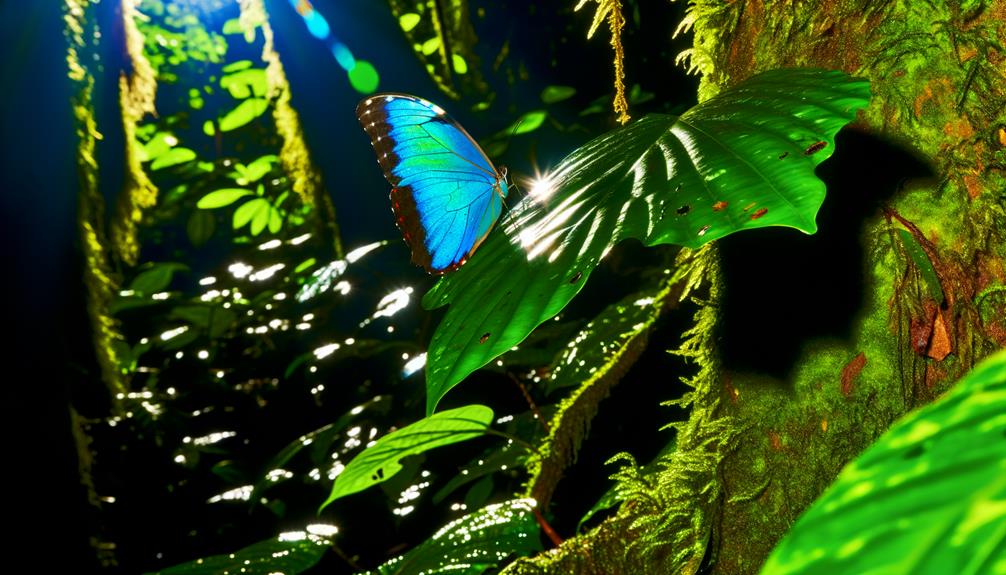
Key Takeaways
- Vivid blue iridescence deters predators and enhances survivability.
- Cryptic ventral wing coloration provides effective camouflage.
- Erratic flight patterns help evade predators in dense forest.
- Feeding on fermenting fruits and tree sap supports nutrient cycling.
Wing Coloration and Camouflage
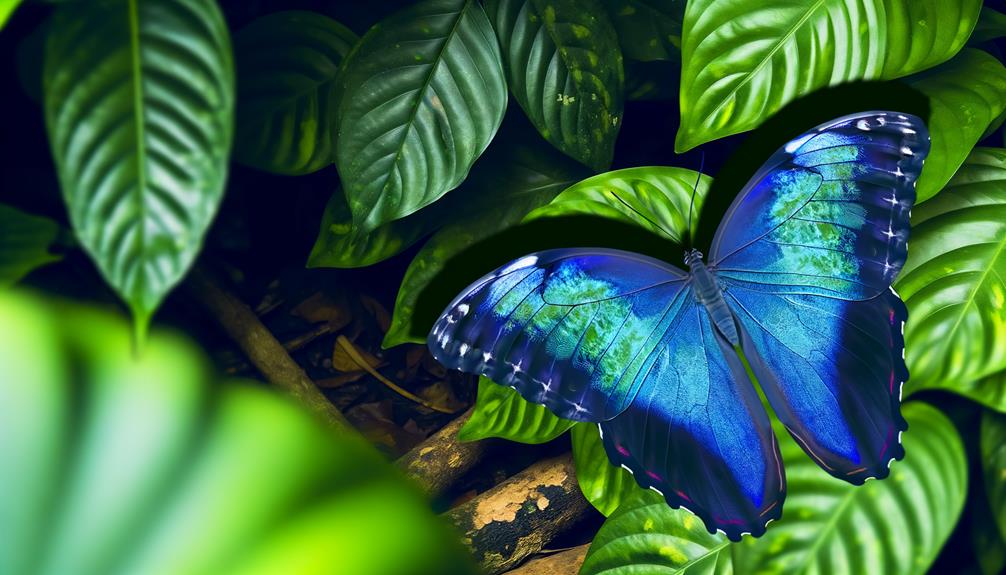
The wing coloration of Blue Morpho butterflies (Morpho spp.) serves dual purposes of iridescence-based signaling and effective camouflage, enhancing their survival in diverse ecological niches.
The upper side of their wings exhibits a vivid blue hue due to structural coloration, wherein microscopic scales reflect specific wavelengths of light. This iridescence functions as a deterrent against predators by creating a visually disorienting effect.
Conversely, the ventral side of the wings is adorned with brown and eyespot patterns, offering cryptic camouflage when the wings are closed. This dual coloration mechanism increases survivability by allowing morphos to evade predators through both visual confusion and concealment.
Such adaptations underscore the evolutionary sophistication of these Lepidoptera in predator-rich tropical rainforests.
Communication Through Colors
In Blue Morpho butterflies, coloration serves as a critical mode of intraspecific communication, facilitating mate recognition and territorial displays. The iridescent blue wings, resulting from microscopic scales that reflect light, are key in these interactions.
Quantitative studies reveal that males exhibit brighter coloration, which is directly correlated with mating success and deterrence of rivals.
Spectrophotometric analyses have confirmed that the reflectance properties vary under different light conditions in the rainforest, optimizing visibility. This adaptive trait enhances reproductive isolation and maintains genetic diversity within populations.
In addition, behavioral observations indicate that wing flashing during flight serves as both an attraction signal to potential mates and a warning to competitors, underpinning their survival and reproductive strategies in the dense canopy.
Feeding Habits and Diet
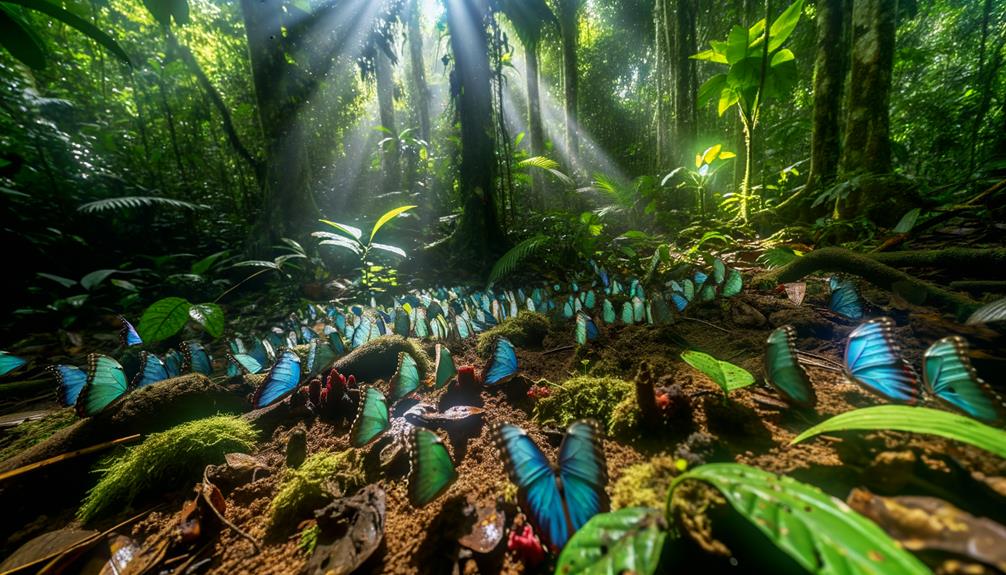
Although Blue Morpho butterflies are mainly known for their striking appearance, their feeding habits are equally fascinating, relying chiefly on the consumption of fermenting fruits and tree sap.
These butterflies utilize their proboscis to extract nutrients from decomposing organic matter. Their dietary preference includes rotting fruits such as bananas, mangoes, and figs, which provide essential carbohydrates and minerals.
Additionally, tree sap consumption offers important amino acids and other nutrients necessary for sustaining their metabolic functions.
Studies indicate that their feeding behavior is significant for maintaining energy levels required for flight and mating activities.
This selective diet supports their ecological role in nutrient cycling within the rainforest, contributing to both forest health and the butterflies' survival strategy.
Life Cycle Strategies
Blue Morpho butterflies exhibit a complex life cycle strategy, encompassing distinct stages from egg to adult that are intricately adapted to their rainforest habitat.
The oviposition occurs on host plants, particularly leguminous species, ensuring larval access to ideal resources. Upon hatching, the larvae display cryptic coloration, minimizing predation risk. Data indicate that the larval stage lasts approximately 45 days, during which they undergo five instars.
Pupation results in a chrysalis, camouflaged to blend seamlessly with the foliage. The metamorphosis period spans roughly two weeks.
Adults emerge with structurally colored wings that exploit light scattering for predator avoidance. This cyclical process, synchronized with the environmental conditions of the rainforest, underscores the evolutionary adaptations of Blue Morpho butterflies for survival and reproduction.
Behavioral Adaptations
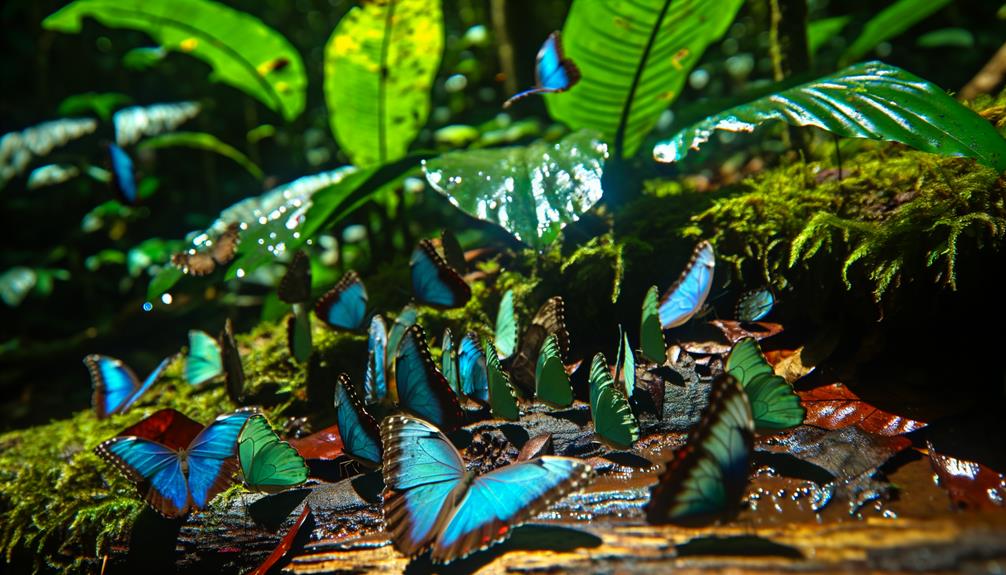
Beyond their intricate life cycle strategies, Blue Morpho butterflies exhibit remarkable behavioral adaptations that enhance their survival and reproductive success in the dense rainforest environment.
Significantly, their erratic flight patterns help evade predators, leveraging sudden bursts of speed and unpredictable trajectories.
During mating season, males patrol territories aggressively, utilizing their iridescent wings to assert dominance and attract females.
Additionally, Blue Morpho butterflies engage in mud-puddling behavior, essential for acquiring important minerals such as sodium, which are scarce in their diet but critical for physiological functions and reproductive success.
These behavioral adaptations, underpinned by evolutionary pressures, optimize their ability to navigate the complex, multifaceted challenges present within their biodiverse habitat, ensuring both individual and species-level persistence.
Conclusion
In conclusion, the blue morpho butterflies exhibit an extraordinary array of adaptations for thriving in the rainforest ecosystem. Their vivid blue wings help deter predators by creating a flashing effect when they fly. Additionally, their brown undersides provide effective camouflage when they rest, allowing them to blend into the dense foliage of the blue morpho butterfly habitat. These adaptations ensure their survival in the competitive and diverse rainforest environment.
Their wing coloration serves dual purposes of camouflage and communication, effectively deterring predators and facilitating intra-species interaction.
Feeding habits align with available resources, ensuring sustenance, while life cycle strategies maximize survival rates.
Behavioral adaptations, such as flight patterns and territoriality, further enhance their ecological success.
These multifaceted adaptations render the blue morpho butterflies nothing short of evolutionary marvels in the complex rainforest environment.





